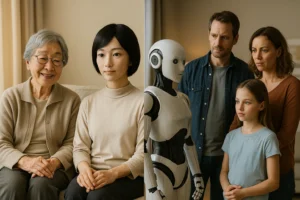Loneliness has become one of the most pressing social challenges of our time. Despite living in a hyper-connected world, millions of people across all age groups report feeling isolated and disconnected. Artificial companions — from lifelike robots to AI-powered dolls — are now being considered as possible solutions to this growing issue. While controversial to some, their potential to provide comfort, conversation, and companionship makes them worth exploring beyond stereotypes.
Understanding the Loneliness Epidemic
In recent years, loneliness has been described as a public health concern. Studies have shown that long-term isolation can negatively impact both mental and physical health, increasing the risk of depression, anxiety, and even cardiovascular diseases. Factors like urbanization, remote work, and shrinking family structures have left many individuals without strong social connections. This has sparked the need for alternative forms of companionship, where technology can play an important role.
The Rise of Artificial Companions
Artificial companions have evolved from static objects into interactive entities that can engage in conversation, learn behaviors, and provide emotional support. Unlike simple chatbots, modern AI companions are designed to recognize human emotions, adapt to their owner’s needs, and simulate meaningful interactions. Their role is not to replace human connection but to fill the gaps when real-life companionship is not available.
Benefits of Artificial Companionship
Artificial companions can offer several advantages in reducing loneliness:
- Accessibility – They are available 24/7, without judgment or emotional withdrawal.
- Consistency – They provide stable companionship, especially for people who struggle with unpredictable social interactions.
- Therapeutic Support – For individuals with social anxiety, companions create a safe environment to practice communication.
- Elderly Care – Seniors often face isolation, and lifelike AI companions can provide reminders, friendly conversation, and emotional comfort.
These benefits highlight how artificial companionship can serve as more than just novelty; they can actively contribute to better well-being.
Criticism and Ethical Concerns
Despite the potential benefits, critics raise valid concerns. Some fear that reliance on artificial companions could reduce motivation to seek human relationships. Others question whether technology can truly provide the depth of connection that people need. Ethical debates also revolve around whether it is healthy to blur the line between human and machine interaction. Addressing these concerns requires balancing innovation with responsibility, ensuring that artificial companions are positioned as complementary rather than replacements.
Real-Life Applications Already in Use
The use of artificial companions is no longer hypothetical. In Japan, lifelike robots are already being introduced into elderly care homes to reduce isolation and provide conversation. AI-driven apps are being used worldwide to support individuals struggling with loneliness or depression. Similarly, companion robots are finding a place in therapy for children with autism, helping them learn communication and empathy in a controlled environment. These examples show that artificial companionship is not a distant future — it is happening today.
The Future of Companionship Technology
Looking ahead, advancements in AI and robotics will only make companions more realistic and emotionally intelligent. Integration with smart homes, wearable devices, and virtual reality could create immersive experiences that feel increasingly human. While challenges remain, especially in terms of ethics and social acceptance, the growing loneliness crisis suggests that artificial companions will continue to gain relevance as society seeks new ways to stay connected.
Final Thoughts
Artificial companions are not meant to replace friends, family, or human relationships. Instead, they represent an innovative tool that can help reduce loneliness in situations where social connections are lacking. As society adapts to technological change, these companions may become valuable allies in improving emotional well-being and bridging the gap between isolation and connection.






